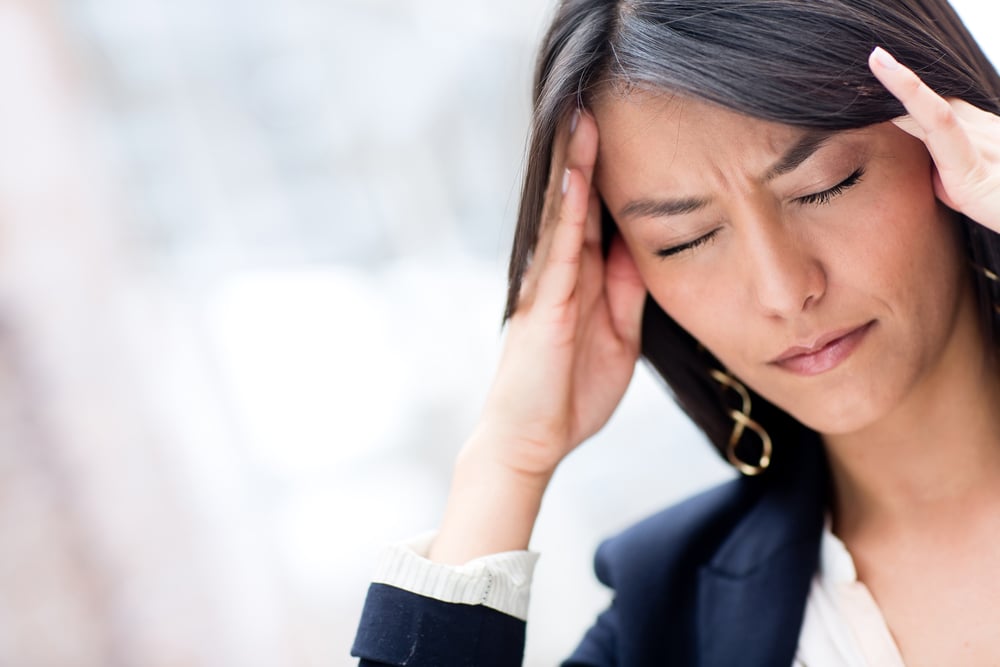What Is Causing My Neck Pain and Headache?
5 min read

The double punch of neck pain with a headache can leave you searching for relief. Sometimes a stiff, painful neck can trigger a headache. Other times, a headache includes neck pain. Treating this pain combo can be a little complex because you’re not exactly sure which came first – the neck pain or the headache! Let’s look at what commonly causes headache and neck pain combos, and how you can get relief.
In most cases, a headache is the primary cause of pain in other areas of the body including the neck. Primary headaches account for about 95% of all headaches, and most include muscle tension and pain in the neck. Sitting in front of a computer for long hours can increase joint irritation and tense muscles in the neck, upper back, and scalp. The result is often a stiff neck and painful headache.
Primary headaches are the result of overactivity in pain-sensitive parts of your brain. There’s a lot going on in your brain. The combination of irritation or inflammation of nerves and blood vessels that surround your skull, plus the chemical reactions constantly happening in your brain, are the usual causes of primary headaches. Add tight muscles in your neck and head, and you’re in for a lot of pain. Other triggers include alcohol, foods containing nitrates (processed meats), lack of sleep, skipped meals, and stress.
Common Types of Primary Headaches
A tension headache causes mild to moderate pain that feels like a tight band around your head. It’s the most common type of headache, and stress is the usual cause. Tension headaches cause dull, aching head pain, with tenderness and tightness in the neck, shoulder, and scalp muscles. They can occur in episodes lasting 30 minutes to a week, up to 15 times a month. Chronic tension headaches last hours or are continuous, occurring more than 15 days a month.
Cluster headache is one of the most painful headache categories, occurring in cyclical patterns. It can wake you from sleep with severe pain around one eye. Frequent headaches occur during cluster periods, which can last from weeks to months. Cluster headaches start and end quickly without warning and leave you exhausted. Symptoms occur only on the affected side and can include redness and tearing in one eye, drooping eyelid, swelling around the eye, runny nose, facial sweating, and sensitivity to light and sound. They are more common in men and often triggered by drinking alcohol.
A migraine headache can cause severe throbbing pain, usually on one side of the head. It often includes nausea and sensitivity to light and sound. Most migraine sufferers also have neck pain before or during the migraine. Pain concentrates in the upper neck and can radiate to your lower neck and shoulders. A migraine can last for hours to days and worsens with activity. One to two days before the migraine, many people have a stiff neck, fluid retention, mood changes, or food cravings. An aura may occur just before a migraine begins, causing flashes of light, vision loss, problems speaking, and tingling or numbness on one side of the face, arm, or leg.
Understanding Secondary Headaches
Secondary headaches are rare (5% of headaches) and are caused by a condition or disease that triggers nerves in the pain-sensitive areas of the head. The headache pain can be linked to a certain activity such as coughing, exercise, straining, or even sex. Secondary headaches can be caused by physical conditions that vary from minor to severe.
Relatively minor conditions include:
- Sinus, nasal, or ear infection
- Dental problems
- Dehydration
- Pressure from tight headgear or goggles
- Overuse of pain medication
- Hangovers
More severe cases include the following and need to be addressed by a physician:
- High blood pressure
- Flu or Covid-19
- Blood clot in the brain
- Brain or artery inflammation
- Stroke
- Meningitis
- Concussion
- Glaucoma
- Brain tumor
Contact your physician if you feel that your headache is
- is so severe you can’t function normally
- occurring regularly such as every day and does not get better with over-the-counter headache medicines.
- alongside other symptoms, such as confusion, a fever, a stiff neck, or other signs of a concussion, stroke, or meningitis.
Causes of Headaches That Start in the Neck
Secondary headaches caused by neck problems include:
- Cervicogenic headache usually affects only one side of the head, starting at the back and moving forward moving to the forehead, eyes, and ears. They are caused by a problem in a joint, disk, nerve, or muscle in the neck, which can be caused by a fracture, dislocation, or whiplash injury. They’re also caused by rheumatoid arthritis, cancer, or an infection.
- Occipital neuralgia is caused by irritation or injury to the nerve on the back of your skull. It causes sharp, electric-shock sensations, usually on one side of the body. They begin in the upper neck and spread to the back of the head, neck, and ears.
- TMJ (temporomandibular joint in your jaw area) headache can cause neck pain due to muscle soreness or weakness in the TMJ; degeneration of the bone, ligament, or muscles near the TMJ; or TMJ injury. It starts with a dull ache at the temples and feels like an earache. You can develop a TMJ headache if you grind or clench your teeth (bruxism), which causes tight fatigued TMJ muscles.
- Hemicrania continua is a moderately intense headache usually on only one side. If the pain becomes severe, it will spread to the neck, shoulder, and ear.
Treatments for Primary and Secondary Headaches
It’s important that you don’t suffer for long periods of time with headaches. If you’re having headaches more often all of a sudden but don’t have other symptoms of a medical condition such as meningitis, COVID-19, or a stroke, request an appointment with your doctor for an evaluation to see if there is an underlying cause that can be treated so that your headaches can be relieved at their source. If you had a recent blow to the head, car accident, or show symptoms of one of these medical conditions listed above, seek medical help right away!
If your doctor suspects high blood pressure, a herniated disc in the neck or simply too much day to day dress is the cause of your headache there are ways a chiropractor can help.
Chiropractic Care for Headaches
Chiropractic care for headaches can help some patients by relieving the muscle strain and misaligned spine that can be caused by being overly tense for long periods of time. Chiropractic adjustments reduce joint stiffness and inflammation and correct misalignment of the spine and other joints in your body, which can reduce tension headaches.
Massage therapy is another way to help ward of headaches from coming back. By regularly spending time relaxing you can prevent your muscles in the neck and back from getting as tight, causing headaches.
If you have a cervical disc that’s bulging or herniated causing a secondary headache, chiropractic care can help relieve the pressure and speed the healing of the disc.
If you’ve had whiplash or you have pain from a car accident, a chiropractor can also help relieve the headaches and other muscle aches that come with recovering. Be sure you’re checked out by a physician as well to address any other medical conditions that need to be treated as a result of an accident.
Need Headache Relief in The Woodlands?
At Village Chiropractic in The Woodlands, we can help you with primary and secondary headaches. We’ll be sure we understand how you’re feeling, any possible causes and then explain treatment options that have been proven to bring relief from new or long-term neck and headache pain. Request an appointment today to get started on your journey of healing.




